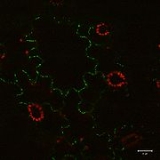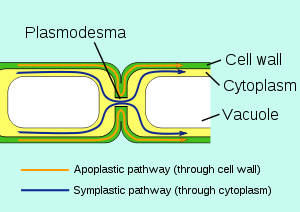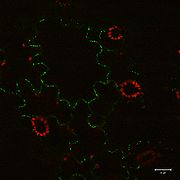
Plasmodesmata
Encyclopedia

Cell wall
The cell wall is the tough, usually flexible but sometimes fairly rigid layer that surrounds some types of cells. It is located outside the cell membrane and provides these cells with structural support and protection, and also acts as a filtering mechanism. A major function of the cell wall is to...
s of plant cells and some algal cells, enabling transport and communication between them. Species that have plasmodesmata include members of the Charophyceae
Charophyceae
Charophyceae is a taxon of green algae whose exact rank is the matter of some current debate. Some botanists recommend expanding the existing plant kingdom to include charophyceans and chlorophytes while others consider Charophyceae to be a class within either the divisions Chlorophyta,...
, Charales
Charales
Charales is an order of pondweeds, freshwater algae in the division Charophyta. They are green plants believed to be the closest relatives of the green land plants. Linnaeus established the genus Chara in 1753.-Description:...
and Coleochaetales
Coleochaetales
The Coleochaetales are an order of parenchymous charophyte algae, so they represents one of the most primitive multicellular relatives of land plants.They questionably include the fossil genus Parka....
(which are all algae), as well as all embryophytes, better known as land plants. Unlike animal cells, every plant cell
Plant cell
Plant cells are eukaryotic cells that differ in several key respects from the cells of other eukaryotic organisms. Their distinctive features include:...
is surrounded by a polysaccharide
Polysaccharide
Polysaccharides are long carbohydrate molecules, of repeated monomer units joined together by glycosidic bonds. They range in structure from linear to highly branched. Polysaccharides are often quite heterogeneous, containing slight modifications of the repeating unit. Depending on the structure,...
cell wall
Cell wall
The cell wall is the tough, usually flexible but sometimes fairly rigid layer that surrounds some types of cells. It is located outside the cell membrane and provides these cells with structural support and protection, and also acts as a filtering mechanism. A major function of the cell wall is to...
. Neighbouring plant cells are therefore separated by a pair of cell walls and the intervening lamella, forming an extracellular domain known as the apoplast
Apoplast
Within a plant, the apoplast is the free diffusional space outside the plasma membrane. It is interrupted by the Casparian strip in roots, air spaces between plant cells and the cuticula of the plant....
. Although cell walls are permeable to small soluble proteins and other solutes, plasmodesmata enable direct, regulated, symplast
Symplast
The symplast of a plant is the inner side of the plasma membrane in which water can freely diffuse.The plasmodesmata allow the direct flow of small molecules such as sugars, amino acids, and ions between cells...
ic intercellular transport of substances between cells. There are two forms of plasmodesmata: primary ones are formed during cell division and secondary ones can form between mature cells.
Similar structures, called gap junction
Gap junction
A gap junction or nexus is a specialized intercellular connection between a multitude of animal cell-types. It directly connects the cytoplasm of two cells, which allows various molecules and ions to pass freely between cells....
s and membrane nanotube
Membrane nanotube
Membrane nanotubes, membrane nanotubules or cytonemes are long and thin tubes formed from the plasma membrane that connect different animal cells over long distances. Two types of nanotubes have been observed. The first type are less than 0.7 micrometres in diameter, contain actin and carry...
s, interconnect animal cells and stromule
Stromule
Stromules are microscopic structures found in plant cells. Stromules are highly dynamic structures extending from the surface of all plastid types, including proplastids, chloroplasts, etioplasts, leucoplasts, amyloplasts, and chromoplasts...
s form between plastid
Plastid
Plastids are major organelles found in the cells of plants and algae. Plastids are the site of manufacture and storage of important chemical compounds used by the cell...
s in plant cells.
Formation
Plasmodesmata are formed when portions of the endoplasmic reticulumEndoplasmic reticulum
The endoplasmic reticulum is an organelle of cells in eukaryotic organisms that forms an interconnected network of tubules, vesicles, and cisternae...
are trapped across the middle lamella
Middle lamella
The middle lamella is a pectin layer which cements the cell walls of two adjoining cells together. Plants need this to give them stability and so that they can form plasmodesmata between the cells. It is the first formed layer which is deposited at the time of cytokinesis. The cell plate that is...
as new cell wall is laid down between two newly divided plant cells and these eventually become the cytoplasmic connections between cells (primary plasmodesmata). Here the wall is not thickened further, and depressions or thin areas known as pits are formed in the walls. Pits normally pair up between adjacent cells. Alternatively, plasmodesmata can be inserted into existing cell walls between non-dividing cells (secondary plasmodesmata)
Plasmodesmatal plasma membrane
A typical plant cell may have between 103 and 105 plasmodesmata connecting it with adjacent cells equating to between 1 and 10 per µm2. Plasmodesmata are approximately 50-60 nm in diameter at the mid-point and are constructed of three main layers, the plasma membrane, the cytoplasmic sleeve, and the desmotubule. They can transverse cell walls that are up to 90 nm thick.The plasma membrane portion of the plasmodesma is a continuous extension of the cell membrane or plasmalemma It is similar in structure to the cellular phospholipid bilayers.
Cytoplasmic sleeve
The cytoplasmic sleeve is a fluid-filled space enclosed by the plasmalemma and a continuous extension of the cytosolCytosol
The cytosol or intracellular fluid is the liquid found inside cells, that is separated into compartments by membranes. For example, the mitochondrial matrix separates the mitochondrion into compartments....
. Trafficking of molecule
Molecule
A molecule is an electrically neutral group of at least two atoms held together by covalent chemical bonds. Molecules are distinguished from ions by their electrical charge...
s and ion
Ion
An ion is an atom or molecule in which the total number of electrons is not equal to the total number of protons, giving it a net positive or negative electrical charge. The name was given by physicist Michael Faraday for the substances that allow a current to pass between electrodes in a...
s through plasmodesmata occurs through this passage. Smaller molecules (e.g. sugar
Sugar
Sugar is a class of edible crystalline carbohydrates, mainly sucrose, lactose, and fructose, characterized by a sweet flavor.Sucrose in its refined form primarily comes from sugar cane and sugar beet...
s and amino acid
Amino acid
Amino acids are molecules containing an amine group, a carboxylic acid group and a side-chain that varies between different amino acids. The key elements of an amino acid are carbon, hydrogen, oxygen, and nitrogen...
s) and ions can easily pass through plasmodesmata by diffusion
Diffusion
Molecular diffusion, often called simply diffusion, is the thermal motion of all particles at temperatures above absolute zero. The rate of this movement is a function of temperature, viscosity of the fluid and the size of the particles...
without the need for additional chemical energy. Proteins can also pass through the cytoplasmic sleeve (for example Green fluorescent protein
Green fluorescent protein
The green fluorescent protein is a protein composed of 238 amino acid residues that exhibits bright green fluorescence when exposed to blue light. Although many other marine organisms have similar green fluorescent proteins, GFP traditionally refers to the protein first isolated from the...
). It is not yet known how the selective transport of larger molecules, such as proteins, occurs. One hypothesis
Hypothesis
A hypothesis is a proposed explanation for a phenomenon. The term derives from the Greek, ὑποτιθέναι – hypotithenai meaning "to put under" or "to suppose". For a hypothesis to be put forward as a scientific hypothesis, the scientific method requires that one can test it...
is that the polysaccharide
Polysaccharide
Polysaccharides are long carbohydrate molecules, of repeated monomer units joined together by glycosidic bonds. They range in structure from linear to highly branched. Polysaccharides are often quite heterogeneous, containing slight modifications of the repeating unit. Depending on the structure,...
callose
Callose
Callose is a plant polysaccharide. It is composed of glucose residues linked together through β-1,3-linkages, and is termed a β-glucan. It is thought to be manufactured at the cell wall by callose synthases and is degraded by β-1,3-glucanases. It is laid down at plasmodesmata, at the cell...
accumulates around the neck region of plasmodesmata to form a collar, reducing their diameter and thereby controlling permeability to substances in the cytoplasm.
Desmotubule
The desmotubule is a tube of appressed endoplasmic reticulum that runs between two adjacent cells Some molecules are known to be transported through this channel, but it is not thought to be the main route for plasmodesmatal transport.Around the desmotubule and the plasma membrane areas of an electron dense material have been seen, often joined together by spoke-like structures that seem to split the plasmodesma into smaller channels These structures may be composed of myosin
Myosin
Myosins comprise a family of ATP-dependent motor proteins and are best known for their role in muscle contraction and their involvement in a wide range of other eukaryotic motility processes. They are responsible for actin-based motility. The term was originally used to describe a group of similar...
and actin
Actin
Actin is a globular, roughly 42-kDa moonlighting protein found in all eukaryotic cells where it may be present at concentrations of over 100 μM. It is also one of the most highly-conserved proteins, differing by no more than 20% in species as diverse as algae and humans...
, which are part of the cell's cytoskeleton
Cytoskeleton
The cytoskeleton is a cellular "scaffolding" or "skeleton" contained within a cell's cytoplasm and is made out of protein. The cytoskeleton is present in all cells; it was once thought to be unique to eukaryotes, but recent research has identified the prokaryotic cytoskeleton...
. If this is the case these proteins could be used in the selective transport of large molecules between the two cells.
Transport

Protein
Proteins are biochemical compounds consisting of one or more polypeptides typically folded into a globular or fibrous form, facilitating a biological function. A polypeptide is a single linear polymer chain of amino acids bonded together by peptide bonds between the carboxyl and amino groups of...
s (including transcription factors), short interfering RNA, messenger RNA
Messenger RNA
Messenger RNA is a molecule of RNA encoding a chemical "blueprint" for a protein product. mRNA is transcribed from a DNA template, and carries coding information to the sites of protein synthesis: the ribosomes. Here, the nucleic acid polymer is translated into a polymer of amino acids: a protein...
and viral genome
Genome
In modern molecular biology and genetics, the genome is the entirety of an organism's hereditary information. It is encoded either in DNA or, for many types of virus, in RNA. The genome includes both the genes and the non-coding sequences of the DNA/RNA....
s from cell to cell. One example of a viral movement proteins
Movement Proteins
Successful infection of a plant by a plant virus depends on its ability to move from the cell initially infected to neighbouring cells in order to spread infection. Unlike animal cells, plant cells have robust cell walls, which viruses cannot easily penetrate...
is the tobacco mosaic virus
Tobacco mosaic virus
Tobacco mosaic virus is a positive-sense single stranded RNA virus that infects plants, especially tobacco and other members of the family Solanaceae. The infection causes characteristic patterns on the leaves . TMV was the first virus to be discovered...
MP-30. MP-30 is thought to bind to the virus's own genome and shuttle it from infected cells to uninfected cells through plasmodesmata. Flowering Locus T protein moves from leaves to the shoot apical meristem
Meristem
A meristem is the tissue in most plants consisting of undifferentiated cells , found in zones of the plant where growth can take place....
through plasmodesmata to initiate flowering.
The size of molecules that can pass through plasmodesmata is determined by the size exclusion limit. This limit is highly variable and can is subject to active modification. MP-30 is able to increase the size exclusion limit from 700 Daltons to 9400 Daltons thereby aiding its movement through a plant.
Several models for possible active transport through plasmodesmata exist. It has been suggested that such transport is mediated by interactions with proteins localized on the desmotubule, and/or by chaperones partially unfolding
Protein folding
Protein folding is the process by which a protein structure assumes its functional shape or conformation. It is the physical process by which a polypeptide folds into its characteristic and functional three-dimensional structure from random coil....
proteins, allowing them to fit through the narrow passage. A similar mechanism may be involved in transporting viral nucleic acids through the plasmodesmata.

